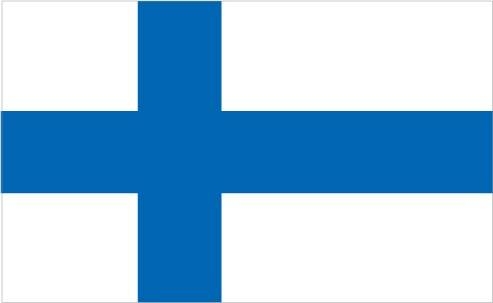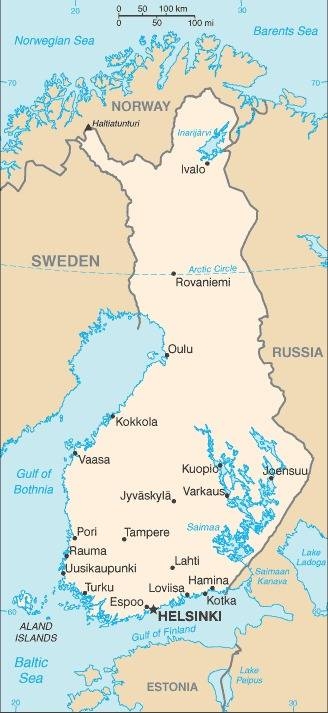67 Finland

White with a blue cross extending to the edges of the flag. The vertical part of the cross is shifted to the hoist side in the style of the Dannebrog (Danish flag). The blue represents the thousands of lakes scattered across the country, while the white is for the snow that covers the land in winter.
Flag courtesy of the CIA World Factbook

Map courtesy of the CIA World Factbook

Completed in 1868, the Uspenski Russian Orthodox Cathedral in Helsinki is the largest Russian Orthodox church in Western or Central Europe.
Photo courtesy of the CIA World Factbook
Government
According to Britannica, Finland adopted a republican constitution in 1919; it has been amended several times, notably in the mid-1990s. Legislative power rests in the unicameral parliament (Eduskunta), whose members are elected for four-year terms, and in the president, whose term is six years. Executive power is shared by the president and the Council of State, or cabinet, the meetings of which are chaired by the president. The president appoints the prime minister and the cabinet. A clause in the constitution stresses that government ministers are responsible to the parliament.
The six-year term of office and the possibility of reelection enhance the president’s powers and provide the country with an important source of stability, in view of the frequent changes of government caused by the multiparty system. In cases of complete deadlock, the president can appoint a nonpolitical caretaker government. Government bills can be introduced into the parliament in the president’s name; the president can refuse to sign a bill but must endorse it if it is passed in a subsequent parliament. The president also can dissolve the parliament, has certain decree-making powers, and is the head of the armed forces. Moreover, the president conducts the country’s foreign policy, but decisions on major treaties and questions of war and peace must be validated by the parliament.
Finland is divided into 19 maakunnat (regions; singular maakunta), including the autonomous region of Åland (Ahvenanmaa). Each regular maakunta is governed by a council. The country was divided into 12 läänit (provinces) until 1997, when that number was reduced to five, plus the autonomous territory of Åland, all of which were subdivided into maakunnat. In 2010, however, the läänit were abolished, and the existing maakunnat divisions became the primary administrative units. To aid with the transition, six regional state administrative agencies were established that same year to work with the local authorities. The regional state administrative agencies assisted in such areas as basic public services, health, safety, and environmental protection. Finland is further divided into more than 300 local authorities (municipalities), the majority of which have fewer than 10,000 residents.
Åland has special status as a demilitarized, self-governing region. The Act on the Autonomy of Åland (1920), settled by a decision of the League of Nations (1921), provided for Finnish sovereignty over Åland, predicated on a division of political power between the islands and the rest of Finland. Åland has its own parliament (Lagtinget), flag, and representative on the Nordic Council.
The Finnish judiciary is independent of the legislature and executive; judges are removable only by judicial sentence. There are local, municipal, and rural district courts (käräjäoikeus) held in cities and towns by the chief judge (oikeuspormestari) and assistants and in the country by a judge and jurors. Appeal from these courts lies to courts of appeal in Helsinki, Turku, Vaasa, Kuopio, Kouvola, and Rovaniemi. The Supreme Court (Korkein oikeus), in Helsinki, appoints the district judges and those of the appeal courts. The chancellor of justice (oikeuskansleri) is the supreme judicial authority and also acts as public prosecutor. The parliament appoints a solicitor general, who acts as an ombudsman. The Supreme Administrative Court (Korkein hallintooikeus) is the highest tribunal for appeals in administrative cases.
Finnish Transport and Communication Agency – Traficom
The Finnish Transport and Communications Agency Traficom is an authority in license, registration and approval matters. The Agency will promote the transport system and safety of traffic and ensure that everyone in Finland has access to high-quality and secure communications connections and services. The Finnish Transport Safety Agency (Trafi), the Finnish Communications Regulatory Authority (FICORA) and certain functions of the Finnish Transport Agency merged to form the new Finnish Transport and Communications Agency Traficom on 1 January 2019.
Airspace
SkyVector – Google Maps – ADS-B Exchange
ICAO countries publish an Aeronautical Information Publication (AIP). This document is divided into three parts: General (GEN), En Route (ENR) and Aerodromes (AD). ENR 1.4 details the types of airspace classes they chose to adopt from classes A through G.
Drone Regulations
Advanced Air Mobility (AAM) Regulations & Policies
Bilateral agreements facilitate the reciprocal airworthiness certification of civil aeronautical products imported/exported between two signatory countries. A Bilateral Airworthiness Agreement (BAA) or Bilateral Aviation Safety Agreement (BASA) with Implementation Procedures for Airworthiness (IPA) provides for airworthiness technical cooperation between the FAA and its counterpart civil aviation authorities.
Reciprocal acceptance of aviation safety-related approvals and services with the European Union Aviation Safety Agency (EASA) and Member States of the European Union are primarily governed by the U.S. – European Union Safety Agreement.
Note: The European Union has designated that import, export, and oversight of certain ‘low risk’ civil aviation products are not covered by the EU, and will be administered by individual EU Member State aviation authorities. These products are defined in Annex 1 of REGULATION (EU) 2018/1139 (formerly known as “Annex 2 aircraft”). FAA validation/U.S. import of these products will be governed by the BAA between the FAA and that EU Member State aviation authority, not the US-EU Safety Agreement.
Legacy Bilateral Airworthiness Agreement (BAA): Contact AIR-40 at 9-AWA-AVS-AIR400@faa.gov for assistance when using this legacy BAA in support of a project, and before contacting an Authority about use and effectivity of this document.
Advanced Air Mobility (AAM) News
2025
Video courtesy of Advanced Air Mobility Institute from the January 2025 Global AAM Forum. Complete session for Day 2 of this Forum is available on the Advanced Air Mobility Institute YouTube Channel
2025 – ANRA to provide U-space system for Finnish research center
2024 – ANRA partners with Flyby Guys on drone services in Europe
2023 – Study on the Future of Helsinki’s Urban Air Mobility
2022 – New Aerospace Research Center to Drive Drone and UAM Innovation in Finland
Short Essay Questions
Scenario-Based Question
You have been hired by a Drone Startup Company. Your boss has immediately assigned this job to you.
They need you to prepare a one-page memo detailing the legalities of using a drone to film over Helsinki, pictured above.
They need you to mention any national laws and local ordinances.
They specifically want to know what airspace (insert pictures) you will be operating in and whether or not you need an airspace authorization.
Does it matter whether or not you are a citizen of the country?
Lastly, there is a bonus for you if, as you scroll through this chapter, you find any typos or broken links!
Short Essay Questions
- What are the drone categories?
- How is registration addressed?
- How is remote ID addressed?
- What are the model aircraft rules?
- What are the commercial drone rules?
- Are there waivers or exemptions to the rules? If so, for what?
- Would you share a link to an interactive airspace map?
- How is BVLOS addressed?
- How can you fly drones at night?
- How can you fly drones over people?
- Where do you find drone NOTAMs?
- What are the rules for drone maintenance?
- What are the rules for an SMS program?
- What are some unique rules not mentioned above?
- What are the C-UAS rules?
- What are the AAM rules?

